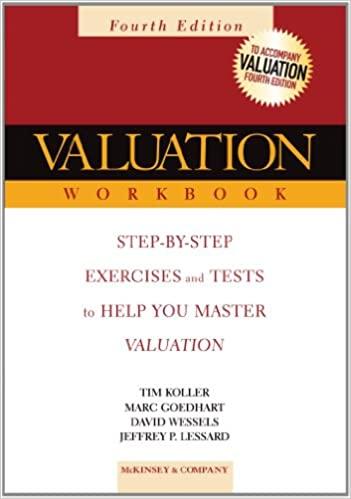Question
Please help with these questions with clarification!!!! Q5. When would you be most likely to use a top-down approach to forecasting revenue? a. As a
Please help with these questions with clarification!!!!
Q5. When would you be most likely to use a top-down approach to forecasting revenue?
| a. | As a stable, mature firm trying to predict next year's sales for your bestselling product. |
| b. | As a startup firm estimating its first year of sales. |
| c. | As a financially distressed firm. |
| d. | As a 10-year private company about to go public in its first IPO. |
Q6.
Your firm's last three years of sales have been $1 million, $2 million, and $3 million (oldest to most recent). Year-end inventory was $250k, $500k, and $750k respectively.
You are considering purchasing an inventory system that will double your inventory turnover. Which of the following is a good estimate for the amount you'll save with regard to inventory investment next year, assuming your sales will be $4 million - i.e., what's the difference between your estimates of inventory with the system and without?
(Assume that your costs of goods sold stay at a constant percentage of sales throughout the past three years and next year; use same-year CoGS/Inv as your inventory turnover formula.)
| a. | 2000 |
| b. | 1500 |
| c. | 200 |
| d. | 500 |
Q7.
You forecast the free cash flows for your target firm over the next five years. The final cash flow, at the end of year five, is projected to be $215 million.
Assuming a FCF terminal growth rate of 2.5% and an overall discount rate of 11%, what is the present valueof all future cash flows after the planning period? (Hint: do not forget to discount to today.)
| a. | $1.50 billion |
| b. | $2.59 billion |
| c. | $2.53 billion |
| d. | $1.54 billion |
| e. | There isn't enough information to answer the question. |
Q8. Which of the following formulas only includes accounts that should be used in the operating net working capital calculation?
| a. | (AR + Inventory + Short term investments) - (AP + Accrued Expenses + Short-term Debt + Current portion of LTD) |
| b. | (AR + Inventory) - (AP + Accrued Expenses + Short-term Debt + Current portion of LTD) |
| c. | (AR + Inventory) - (AP + Accrued Expenses + Short-term Debt) |
| d. | (Short term investments) - (Short-term Debt + Current portion of LTD) |
| e. | (AR + Inventory) - (AP + Accrued Expenses) |
Step by Step Solution
There are 3 Steps involved in it
Step: 1

Get Instant Access to Expert-Tailored Solutions
See step-by-step solutions with expert insights and AI powered tools for academic success
Step: 2

Step: 3

Ace Your Homework with AI
Get the answers you need in no time with our AI-driven, step-by-step assistance
Get Started


